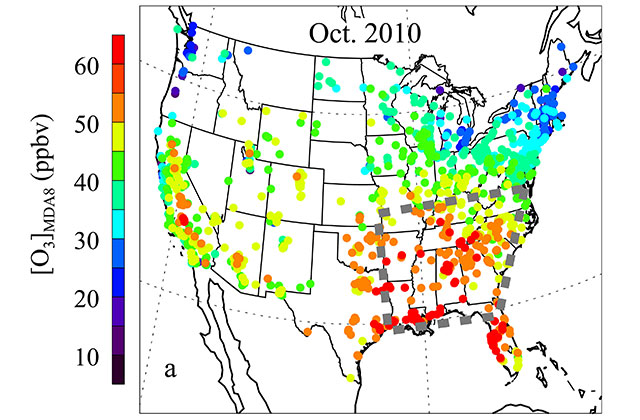While the news is full of articles about the drought in the West, the Southeast of the United States is not faring well either as drought conditions contribute to alarming concentrations of toxic gas.
According to a study published yesterday (August 22) in the Early Edition of the journal Proceedings of the National Academy of Sciences, the region’s ozone season, traditionally in July and August, may stretch into the fall as climate change makes weather “warmer and drier.”
“This study shows that our air quality, particularly ozone in the fall, is becoming more sensitive to the effects of climate change,” said Georgia Tech professor Yuhang Wang, one of the study’s researchers, to the Georgia Tech News Center. “The direction of climate change is such that we are likely going to see hotter and drier fall seasons, which may create larger ozone extremes in the Southeast. We are likely to have record ozone days in the fall, and we need to prepare for that.”
Ozone occurs naturally in the Earth’s upper atmosphere, yet people should not breathe it. The gas forms when different chemicals react in the presence of sunlight and “can trigger chest pain, coughing, throat irritation and airway inflammation,” according to the EPA.
Ozone summertime pollution levels are dipping in the Southeast because of the Clean Air Act, which places tighter regulations on cars and trucks. Vehicles create ozone through their emission of volatile organic compounds. However, with droughts now lasting longer than they once did, vehicles are no longer the only troublesome source—trees are, according to the study. “The [study] is believed to be the first to connect variations in ground-level ozone concentrations to the drought stress on trees,” according to the Georgia Tech News Center.
Wang and his co-researcher Yuzhong Zhang looked at ground-level ozone data from 1980 to 2010 within Arkansas, Louisiana, Tennessee, Mississippi, Alabama, Georgia, North Carolina and South Carolina. The 2010 census data showed that the U.S. Black population is concentrated in this region: 55 percent of Black people in the U.S. lived in the South, and 105 Southern counties had a Black population of at least 50 percent.
This places a heavy burden on these communities, which already suffer disproportionately from respiratory health problems. When it comes to asthma hospitalizations, Black children are four times more likely than White boys and girls to be admitted. In 2013, Black people were three times more likely to die from asthma-related causes than their White counterparts, according to the U.S. Department of Health and Human Services.
If ozone pollution levels worsen, as this study suggests, people will have to take extra ozone mitigation efforts to protect their health.
